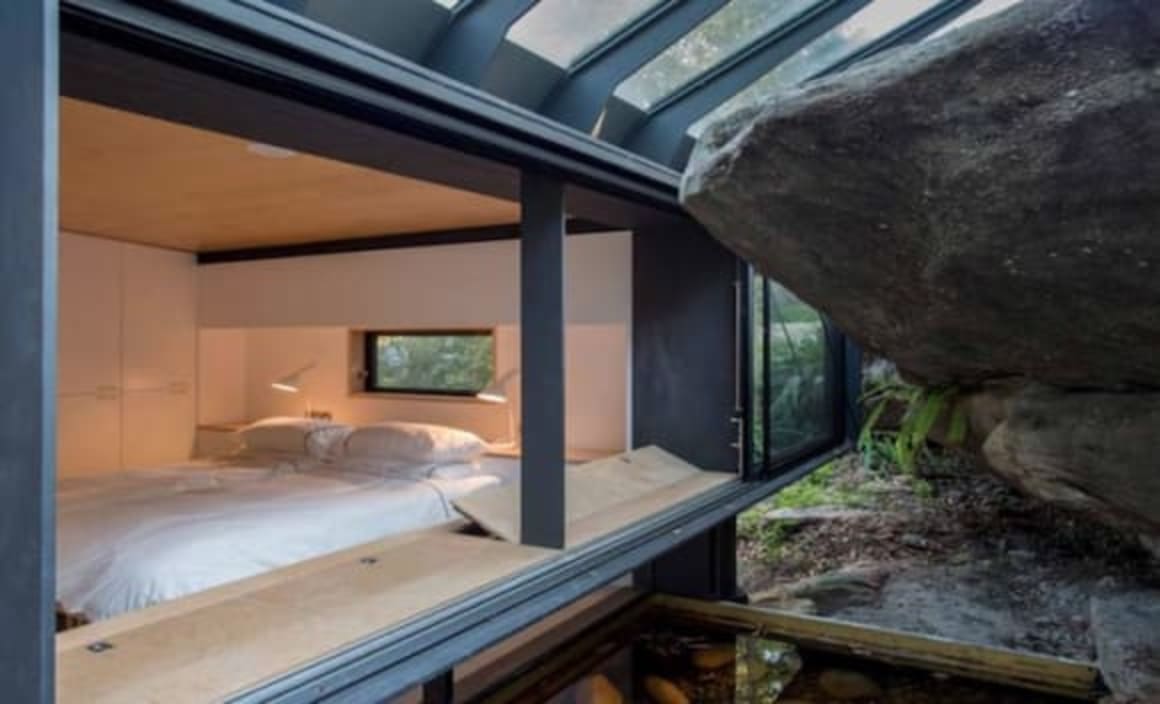Donaldson House at Palm Beach, a house designed by Glenn Murcutt still listed

Around 10 years ago, the internationally acclaimed architect Glenn Murcutt was approached to design a Palm Beach home by two expatriate Australian's living in London.
Their intention was to return to Australia wanting a house for their growing family, initially for use during weekends and holidays but later to become their main residence.
The result was Donaldson House at Palm Beach, a house designed with sensitivity to the landscape, climate and seasons.

Surrounded by native bushland and with views to Pittwater, the home offers the best of a treechange and sea change within the Sydney basin.
The four bedroom home on Bynya Road was only completed in September last year. Circumstance now sees it listed for sale.
Sitting below a sandstone crop on a steep 715 sqm parcel that cost $830,000 in 2003, the home is almost invisible from the street.
The internal space measures 166 square metres with all living spaces and bedrooms configured on the north side of the house to take advantage of the northern sunlight. All its passageways are on the south side of the house.

The master bedroom and bathroom are on the upper level, as are the kitchen, dining and living space that extend to a partially covered veranda with views to the south and west.
Three bedrooms, a bathroom and laundry are on the lower level.
The interior has been described as a calm and tranquil space with white walls, sealed concrete floors and hoop-pine lined ceilings.
The windows open to the native trees and sandstone crops.

On one wall hangs a Tapestry, Orion M.C. by Victor Vasarely, which originally hung in the public lobby of the Harry Seidler-designed Australia Square. The Tapestry was sold in 2003 and an important brief for the Donaldson House was to find a place in the house where the Tapestry could be well viewed.
A suspended concrete staircase descends from the top level of the two-storey house that located in a high fire-risk area.
Its design and construction specifically meets the standards and regulations, with reinforced concrete foundations, steel roof rafters and toughened glass throughout, and the exterior of the house is clad with black-weathered zinc.
The house is economical and sustainable with water storage tanks, solar panels and no air conditioning. Opal white interlayered laminate roof glazing is set over the main stairwell where it has externally mounted, electrically operated, adjustable louvers for controlling light and heat. The two tanks have a total capacity of 7500 litres to be used for the laundry, bathrooms and in case of fire.
Now Modern House agency are seeking offers with a guide price of $ 4.1 million. Palm Beach's median house for four bedders is $2.75 million, according to CoreLogic.
Murcutt is considered Australia's greatest living architect. He won the prestigious Pritzker Architecture Prize in 2002, one of the highest distinctions in architecture.
On its award Murcutt was described as being scrupulously energy conscious.
In announcing the jury’s choice, Thomas J. Pritzker, president of The Hyatt Foundation, said Murcutt was "a stark contrast to most of the highly visible architects of the day."
Pritzker said Murcutt's "works were not large scale, the materials he works with, such as corrugated iron, are quite ordinary, certainly not luxurious; and he works alone."
His modernist inspiration extends well beyond the work of Mies van der Rohe, to the Nordic tradition of Aalto and the Australian wool shed, it was suggested.
Noting an age obsessed with celebrity, the glitz of ‘starchitects,’ backed by large staffs and copious public relations support, the Pritzker Prize jury chairman, J. Carter Brown, commented Murcutt worked in a one-person office on the other side of the world from much of the architectural attention
His houses were testament that aesthetics and ecology can work together to bring harmony to man’s intrusion in the environment, the judges noted.
This article was first published in The Weekend Australian.